Characterizing Post-Storm Beach Recovery Modes: A Field-Based Morphodynamic Study from Dongdao Beach, China
Abstract
1. Introduction
2. Material and Methods
2.1. Study Area and Storm
2.2. Data Gathering and Processing
2.2.1. Profile Data
2.2.2. Wave and Sediment Data
2.3. Study Methodology
2.3.1. Wave Height at the Breaking Point
2.3.2. Intertidal Zone Slope Change Rate
2.3.3. Unit-Width Volume and Its Change Rate
2.3.4. Pearson Correlation Analysis
2.3.5. Kriging Interpolation
2.3.6. Classification of Beach Recovery Modes
3. Results
3.1. Profile Characteristics and Morphological Succession
3.1.1. Profile Characteristics
3.1.2. Variation in Berm, Beach Width, and Slope
3.2. Spatiotemporal Characteristics of Beach Erosion and Accretion
3.2.1. Variation in Unit-Width Volume
3.2.2. Spatial Variation in Beach Erosion and Accretion
3.3. Characteristics of Beach Recovery Rate
4. Discussion
4.1. Factors Influencing Beach Recovery
4.2. Response of Unit-Width Beach Volume to Slope Change
4.3. Four Recovery Modes of the Beach
4.3.1. Mode I: Beach Accretion with Beachface Steepening
4.3.2. Mode II: Beach Erosion with Beachface Steepening
4.3.3. Mode III: Beach Erosion with Beachface Flattening
4.3.4. Mode IV: Beach Accretion with Beachface Flattening
5. Conclusions
Author Contributions
Funding
Data Availability Statement
Acknowledgments
Conflicts of Interest
References
- Forbes, D.L.; Parkes, G.S.; Manson, G.K.; Ketch, L.A. Storms and shoreline retreat in the southern Gulf of St. Lawrence. Mar. Geol. 2004, 210, 169–204. [Google Scholar] [CrossRef]
- Seymour, R.; Guza, R.T.; O’Reilly, W.; Elgar, S. Rapid erosion of a small southern California beach fill. Coast. Eng. 2005, 52, 151–158. [Google Scholar]
- Kossin, J.P.; Knapp, K.R.; Olander, T.L.; Velden, C.S. Global increase in major tropical cyclone exceedance probability over the past four decades. Proc. Natl. Acad. Sci. 2020, 117, 11975–11980. [Google Scholar] [CrossRef] [PubMed]
- Dolan, R.; Davis, R.E. An intensity scale for Atlantic coast Northeast storms. J. Coast. Res. 1992, 8, 978–983. [Google Scholar]
- Guo, J. Research of Embayed Beach Morphodynamics Under the Impacts of Storm Events with Different Intensity Scales; East China Normal University: Shanghai, China, 2022. [Google Scholar]
- Wright, L.D.; Guza, R.T.; Short, A.D. Dynamics of a high-energy dissipative surf zone. Mar. Geol. 1982, 45, 41–62. [Google Scholar] [CrossRef]
- Hwang, B.H.; Do, K.D.; Chang, S.Y. Morphological response of Storm Hinnamnor at Songjeong Beach using UAV-derived data. J. Coast. Res. 2024, 116, 126–130. [Google Scholar] [CrossRef]
- Karunarathna, H.; Pender, D.; Ranasinghe, R.; Short, A.D.; Reeve, D.E. The effects of storm clustering on beach profile variability. Mar. Geol. 2014, 348, 103–112. [Google Scholar] [CrossRef]
- Senechal, N.; Coco, G.; Castelle, B.; Marieu, V. Storm impact on the seasonal shoreline dynamics of a meso- to macrotidal open sandy beach (Biscarrosse, France). Geomorphology 2015, 228, 448–461. [Google Scholar] [CrossRef]
- Cai, F.; Su, X.; Yang, S.; Gao, Z. rapid response to 9914 typhoon-induced storm wave force made by the beach profiles of Xiamen Island. Ocean Eng. 2002, 2, 85–90. [Google Scholar] [CrossRef]
- Sallenger, A.H. Storm impact scale for barrier islands. J. Coast. Res. 2000, 16, 890–895. [Google Scholar]
- Gong, H. Complicated Response of Beach Erosion and Restoration to Consecutive Typhoons-Based on Beaches along Northern and Northeastern Coast in Hainan; East China Normal University: Shanghai, China, 2017. [Google Scholar]
- Vousdoukas, M.I.; Almeida LP, M.; Ferreira, Ó. Beach erosion and recovery during consecutive storms at a steep--slope, meso-tidal beach. Earth Surf. Process. Landf. 2012, 37, 583–593. [Google Scholar] [CrossRef]
- Coco, G.; Senechal, N.; Rejas, A.; Bryan, K.R.; Capo, S.; Parisot, J.P.; Brown, J.A.; MacMahan, J.H. Beach response to a sequence of extreme storms. Geomorphology 2014, 204, 493–501. [Google Scholar] [CrossRef]
- Burvingt, O.; Masselink, G.; Russell, P.; Scott, T. Classification of beach response to extreme storms. Geomorphology 2017, 295, 722–737. [Google Scholar] [CrossRef]
- Gallagher, E.L.; Elgar, S.; Guza, R.T. Observations of sand bar evolution on a natural beach. J. Geophys. Res. Ocean. 1998, 103, 3203–3215. [Google Scholar] [CrossRef]
- Plant, N.G.; Todd Holland, K.; Holman, R.A. A dynamical attractor governs beach response to storms. Geophys. Res. Lett. 2006, 33. [Google Scholar] [CrossRef]
- Scott, T.; Masselink, G.; O’Hare, T.; Saulter, A.; Poate, T.; Russell, P.; Davidson, M.; Conley, D. The extreme 2013/2014 winter storms: Beach recovery along the southwest coast of England. Mar. Geol. 2016, 382, 224–241. [Google Scholar] [CrossRef]
- Yu, F.; Switzer, A.D.; Lau, A.Y.A.; Yeung, H.Y.E.; Chik, S.W.; Chiu, H.C.; Huang, Z.; Pile, J. A comparison of the post-storm recovery of two sandy beaches on Hong Kong Island, southern China. Quat. Int. 2013, 304, 163–175. [Google Scholar] [CrossRef]
- Gallego-Fernández, J.B.; Morales-Sánchez, J.A.; Martínez, M.L.; García-Franco, J.G.; Zunzunegui, M. Recovery of beach-foredune vegetation after disturbance by storms. J. Coast. Res. 2020, 95, 34–38. [Google Scholar] [CrossRef]
- Aagaard, T.; Kroon, A.; Andersen, S.; Sørensen, R.M.; Quartel, S.; Vinther, N. Intertidal beach change during storm conditions; Egmond, The Netherlands. Mar. Geol. 2005, 218, 65–80. [Google Scholar] [CrossRef]
- Houser, C.; Mathew, S. Alongshore variation in foredune height in response to transport potential and sediment supply: South Padre Island, Texas. Geomorphology 2011, 125, 62–72. [Google Scholar] [CrossRef]
- Houser, C.; Hapke, C.; Hamilton, S. Controls on coastal dune morphology, shoreline erosion and barrier island response to extreme storms. Geomorphology 2008, 100, 223–240. [Google Scholar] [CrossRef]
- Priestas, A.M.; Fagherazzi, S. Morphological barrier island changes and recovery of dunes after Hurricane Dennis, St. George Island, Florida. Geomorphology 2010, 114, 614–626. [Google Scholar] [CrossRef]
- Zhang, K.; Douglas, B.; Leatherman, S. Do storms cause long-term beach erosion along the US East Barrier Coast? J. Geol. 2002, 110, 493–502. [Google Scholar] [CrossRef]
- Cheng, J.; Wang, P. Unusual beach changes induced by Hurricane Irma with a negative storm surge and post storm recovery. J. Coast. Res. 2019, 35, 1185–1199. [Google Scholar] [CrossRef]
- Morton, R.A.; Paine, J.G.; Gibeaut, J.C. Stages and durations of post-storm beach recovery, southeastern Texas coast, USA. J. Coast. Res. 1994, 10, 884–908. [Google Scholar]
- Qi, H.; Cai, F.; Lei, G.; Cao, H.; Shi, F. The response of three main beach types to tropical storms in South China. Mar. Geol. 2010, 275, 244–254. [Google Scholar] [CrossRef]
- Poate, T.; Masselink, G.; McCall, R.; Russell, P.; Davidson, M. UK storms 2014: Gravel beach response. In The Proceedings Coastal Sediments; ASCE: San Diego, CA, USA, 2015. [Google Scholar]
- Lee, G.H.; Nicholls, R.J.; Birkemeier, W.A. Storm-driven variability of the beach-nearshore profile at Duck, North Carolina, USA, 1981–1991. Mar. Geol. 1988, 148, 163–177. [Google Scholar] [CrossRef]
- Suanez, S.; Cariolet, J.M.; Cancouët, R.; Ardhuin, F.; Delacourt, C. Dune recovery after storm erosion on a high-energy beach: Vougot Beach, Brittany (France). Geomorphology 2012, 139, 16–33. [Google Scholar] [CrossRef]
- Bramato, S.; Ortega-Sánchez, M.; Mans, C.; Losada, M.A. Natural recovery of a mixed sand and gravel beach after a sequence of a short duration storm and moderate sea states. J. Coast. Res. 2012, 28, 89–101. [Google Scholar] [CrossRef]
- Haerens, P.; Bolle, A.; Trouw, K.; Houthuys, R. Definition of storm thresholds for significant morphological change of the sandy beaches along the Belgian coastline. Geomorphology 2012, 143, 104–117. [Google Scholar] [CrossRef]
- Birkemeier, W.A. The Effects of the 19 December 1977 Coastal Storm on Beaches in North Carolina and New Jersey; Florida Shore and Beach Preservation Association: Tallahassee, FL, USA, 1979. [Google Scholar]
- Feng, X.; Mao, S.; Zhou, Y. Study on the recovery process and the main controlling factors for post-storm beach profiles of a headland bay: Taking the Narrabeen Beach in Australia as an example. Haiyang Xuebao 2023, 45, 80–91. [Google Scholar] [CrossRef]
- Splinter, K.D.; Strauss, D.R.; Tomlinson, R.B. Assessment of post-storm recovery of beaches using video imaging techniques: A case study at Gold Coast, Australia. IEEE Trans. Geosci. Remote Sens. 2011, 49, 4704–4716. [Google Scholar] [CrossRef]
- Jiang, Z.; Shi, L.; Guo, J.; Zhang, M. Storm Response and Recovery Process after Nourishment of Dongsha Beach, Zhujiajian Island, Zhejiang Province. J. Coast. Res. 2020, 95, 231–236. [Google Scholar] [CrossRef]
- Phillips, M.S.; Blenkinsopp, C.E.; Splinter, K.D.; Harley, M.D.; Turner, I.L. Modes of berm and beachface recovery following storm reset: Observations using a continuously scanning lidar. J. Geophys. Res. Earth Surf. 2019, 124, 720–736. [Google Scholar] [CrossRef]
- Zeng, C.; Zhu, S.; Li, Z.; Chen, D.; Zhang, H. High-frequency in situ measurements of beach responses to Tropical Storm Bebinca at Qing’an Bay, Guangdong Province, China. In Proceedings of the 19th Chinese Conference on Ocean (Coastal) Engineering. Ocean (Coastal) Engineering Proceedings, Chongqing, China, 11–13 October 2019; Ocean Press: Beijing, China, 2019; pp. 655–660. [Google Scholar]
- Yangjiang Municipal People’s Government. Yangjiang Municipal People’s Government Gazette. 2019. Available online: http://www.yangjiang.gov.cn (accessed on 20 October 2024).
- Hu, P.; Li, Z.; Zeng, C.; Zhu, D.; Liu, R.; Su, Q.; Tang, J.; Zhu, Y. Bed level changes in the surf zone during post-storm beach recovery. Front. Mar. Sci. 2023, 10, 1233068. [Google Scholar] [CrossRef]
- Liu, L.; Sun, Y.; Liu, R.; Wei, X.; Li, Z. Evaluation of the applicability of beach erosion and accretion index in Qiongzhou Strait of China. Front. Mar. Sci. 2024, 11, 1453439. [Google Scholar] [CrossRef]
- Kumar, V.S.; Anand, N.M.; Chandramohan, P.; Naik, G.N. Longshore sediment transport rate—Measurement and estimation, central west coast of India. Coast. Eng. 2003, 48, 95–109. [Google Scholar] [CrossRef]
- Li, G.; Li, Z.; Zhu, S.; Zhang, H.; Zeng, C. Comparative Study on Grain-size Parameters of Marine Sediment Derived from Graphic and Moment Methods. J. Guangdong Ocean Univ. 2020, 40, 96–101. [Google Scholar] [CrossRef]
- Friedman, G.M. Comparison of moment measures for sieving and thin-section data in sedimentary petrological studies. J. Sediment. Res. 1962, 32, 15–25. [Google Scholar] [CrossRef]
- Komar, P.D.; Gaughan, M.K. Airy wave theory and breaker height prediction. In Coastal Engineering 1972. Coastal Engineering Proceedings, Reston, VA, USA; American Society of Civil Engineers: Reston, VA, USA, 1972; pp. 405–418. [Google Scholar]
- Burvingt, O.; Masselink, G.; Scott, T.; Davidson, M.; Russell, P. Climate forcing of regionally-coherent extreme storm impact and recovery on embayed beaches. Mar. Geol. 2018, 401, 112–128. [Google Scholar] [CrossRef]
- Pearson, K. Mathematical contributions to the theory of evolution. III. Regression, heredity, and panmixia. Philos. Trans. R. Soc. A 1896, 187, 253–318. [Google Scholar] [CrossRef]
- Zeng, C.; Hu, T.; Zhang, H.; Li, Z.; Li, G.; Tian, Y. Wave Motion Response Characteristics of Swash Zone to Typhoon Wipha at Qing’an Bay in Xuwen, Guangdong Province, China. J. Guangdong Ocean Univ. 2021, 41, 74–83. [Google Scholar] [CrossRef]
- Li, Z.; Cai, F.; Lei, G.; Qi, H.; Liu, J. Morphodynamic Analysis of Coastal Evolution Differences on the Sandy Coast of Pinghai, Putian, Fujian. In China Ocean (Coastal) Engineering, Proceedings of the 15th Academic Symposium on China Ocean (Coastal) Engineering, Taiyuan, China, 3–6 August 2011; Part II; Chinese Society of Ocean Engineering: Beijing, China, 2011; pp. 338–343. [Google Scholar]
- Li, Z.; Chen, Z. Progress in the Studies on Beach Profile Shapes. Mar. Sci. Bull. 2002, 5, 82–89. [Google Scholar]
- Cao, C.; Mao, Z.; Cai, F.; Qi, H.; Liu, J.; Lei, G.; Zhao, S.; Liu, G. Dynamic geomorphology and storm response characteristics of the promontory-straight beach—A case of Gulei Beach, Fujian. Acta Oceanol. Sin. 2023, 42, 64–78. [Google Scholar] [CrossRef]
- Short, A.D. Handbook of Beach and Shoreface Morphodynamics [M]; Wiley: Chichester, UK, 1999. [Google Scholar]
- Castelle, B.; Coco, G. The morphodynamics of rip channels on embayed beaches. Cont. Shelf Res. 2012, 43, 10–23. [Google Scholar] [CrossRef]
- Daly, C.J.; Bryan, K.R.; Winter, C. Wave energy distribution and morphological development in and around the shadow zone of an embayed beach. Coast. Eng. 2014, 93, 40–54. [Google Scholar] [CrossRef]
- Ge, Z.; Dai, Z.; Pang, W.; Li, S.; Wei, W.; Mei, X.; Huang, H.; Gu, J. LIDAR-based detection of the post-typhoon recovery of a meso-macro-tidal beach in the Beibu Gulf, China. Mar. Geol. 2017, 391, 127–143. [Google Scholar] [CrossRef]
- Egense, A.K. Southern California beach changes in response to extraordinary storm. Shore Beach 1989, 57, 14–17. [Google Scholar]
- Ge, Z. Meso-Macro-Tidal Beach Morphodynamics of Beibu Gulf-a Case Study of Yintan Beach in Beihai City; East China Normal University: Shanghai, China, 2019. [Google Scholar]
- Dubois, R.N. Seasonal changes in beach topography and beach volume in Delaware. Mar. Geol. 1988, 81, 79–96. [Google Scholar] [CrossRef]
- Aagaard, T.; Hughes, M.; Baldock, T.; Greenwood, B.; Kroon, A.; Power, H. Sediment transport processes and morphodynamics on a reflective beach under storm and non-storm conditions. Mar. Geol. 2012, 326, 154–165. [Google Scholar] [CrossRef]
- Zhang, D.; Guo, J.; Shi, L.; Chen, W.; Kuang, C.; Xia, X. Non-uniform cumulative responses of beach sedimentary geomorphology to consecutive storms around a meso-macro tidal island. Front. Mar. Sci. 2024, 11. [Google Scholar] [CrossRef]
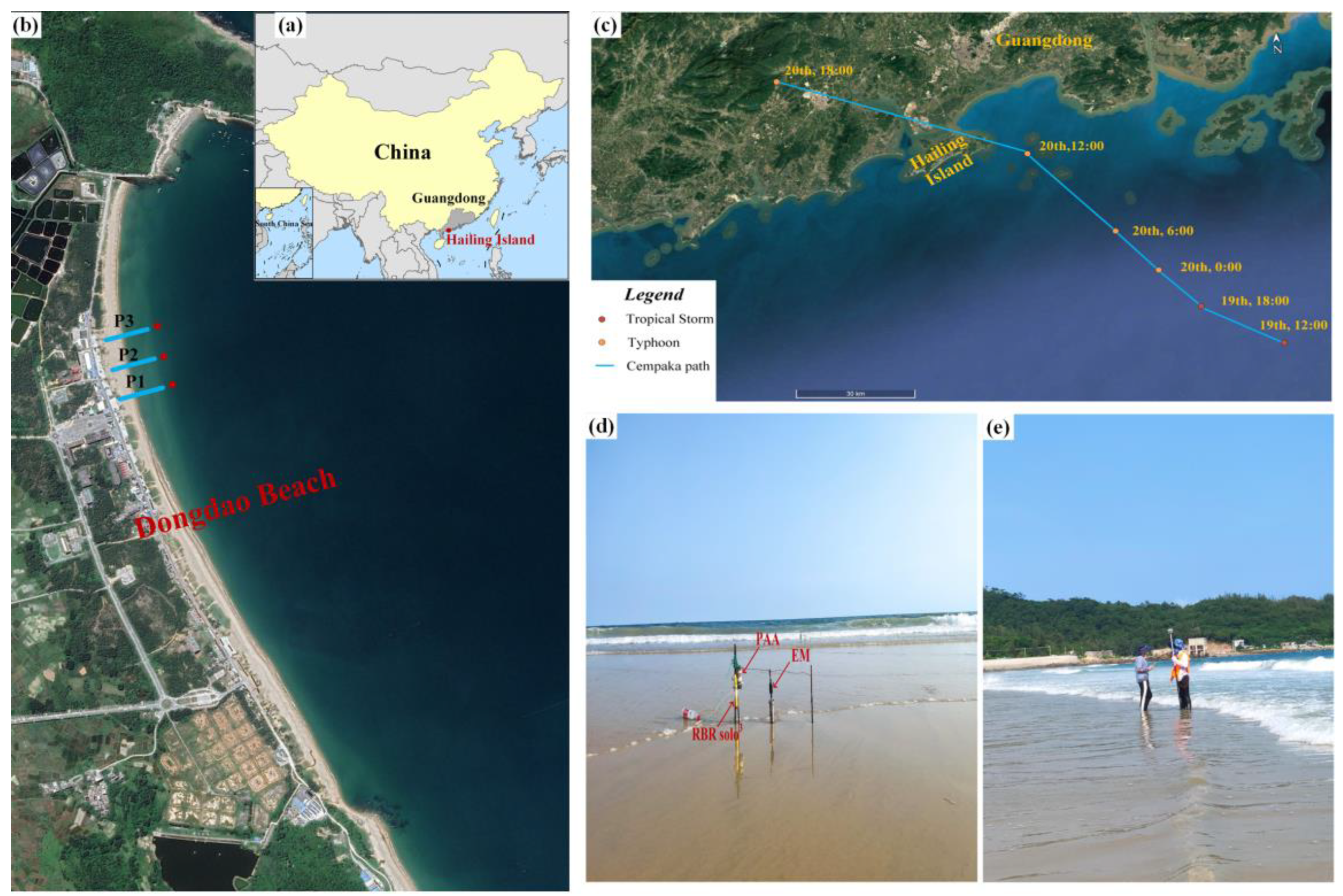

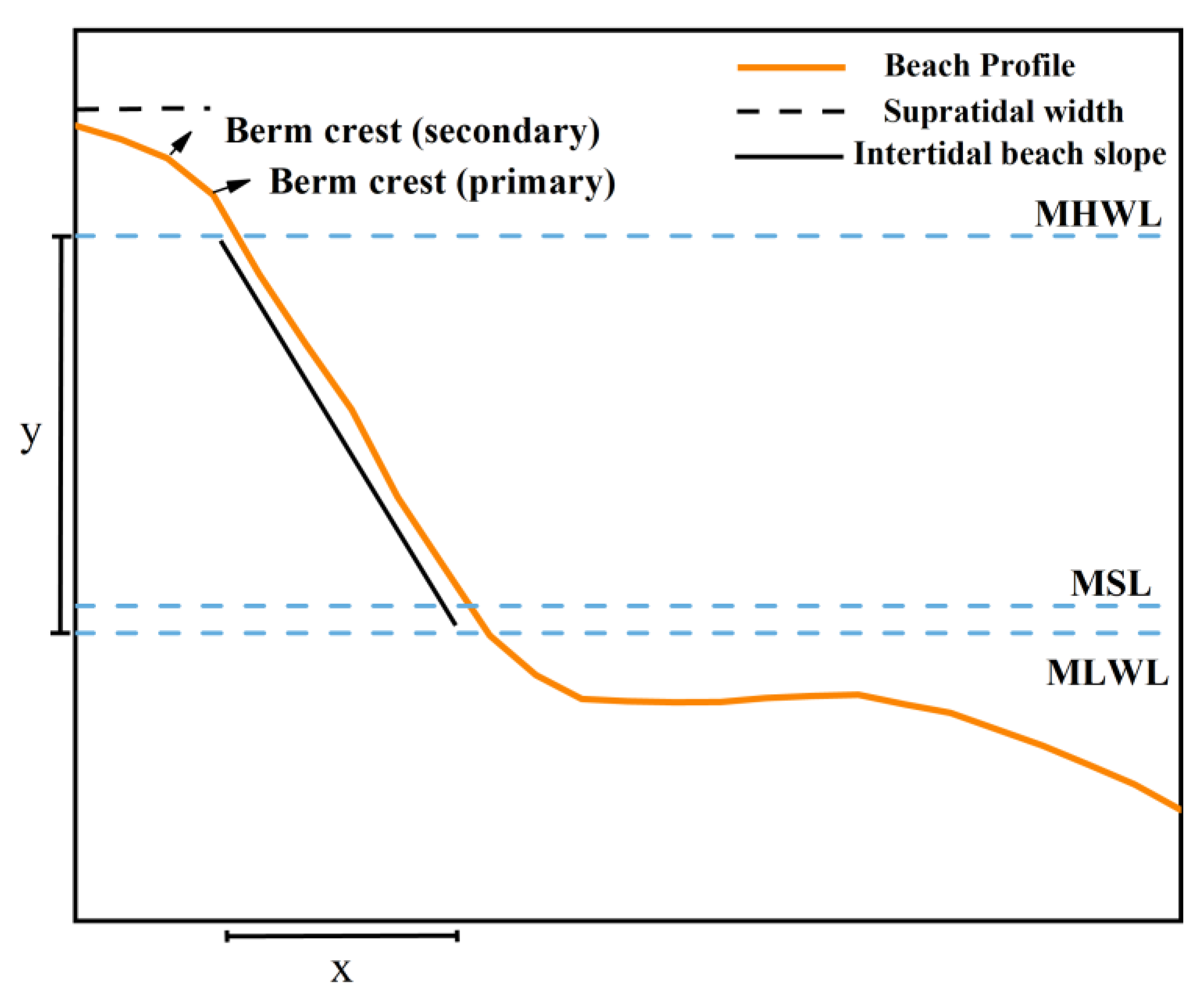

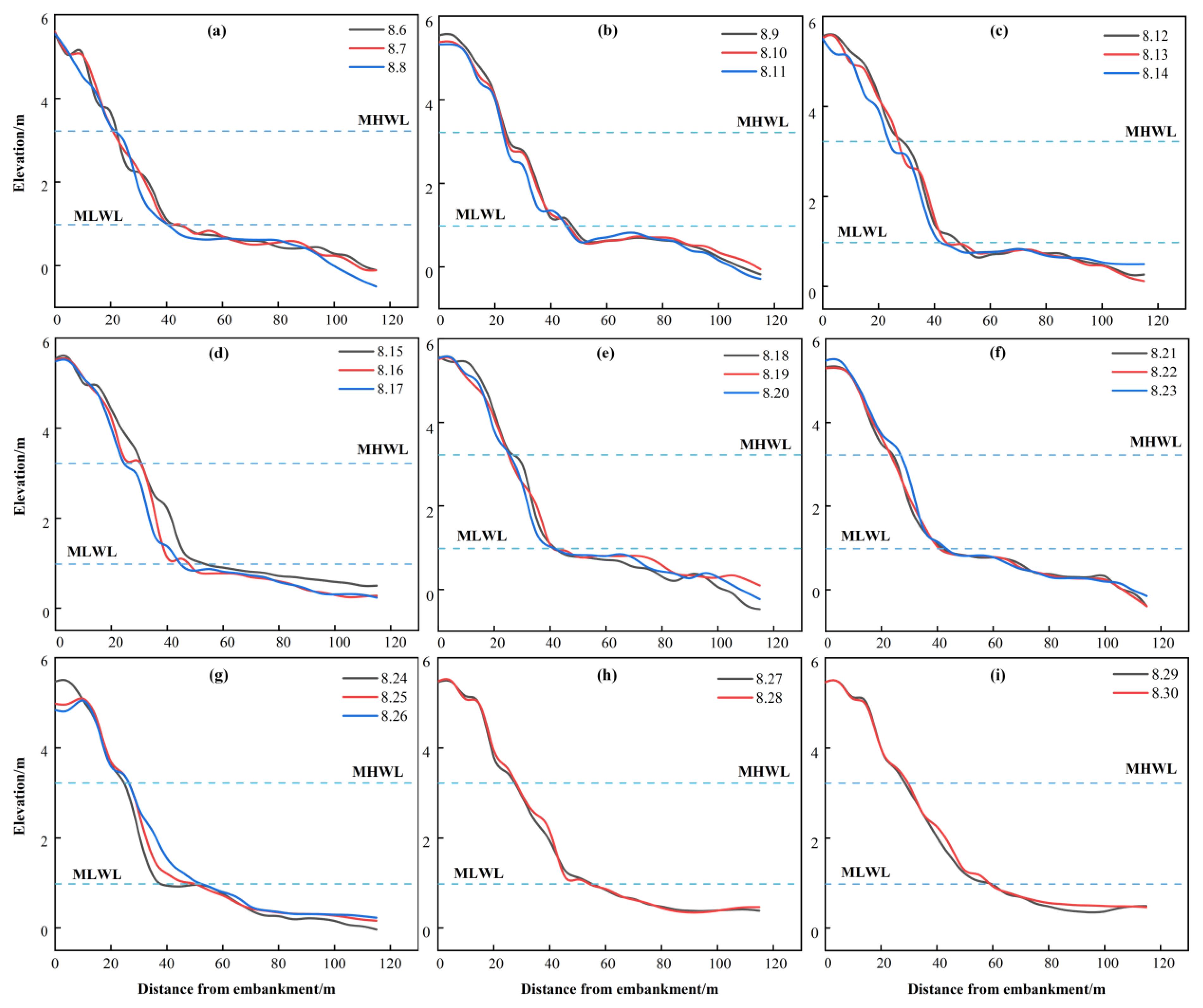
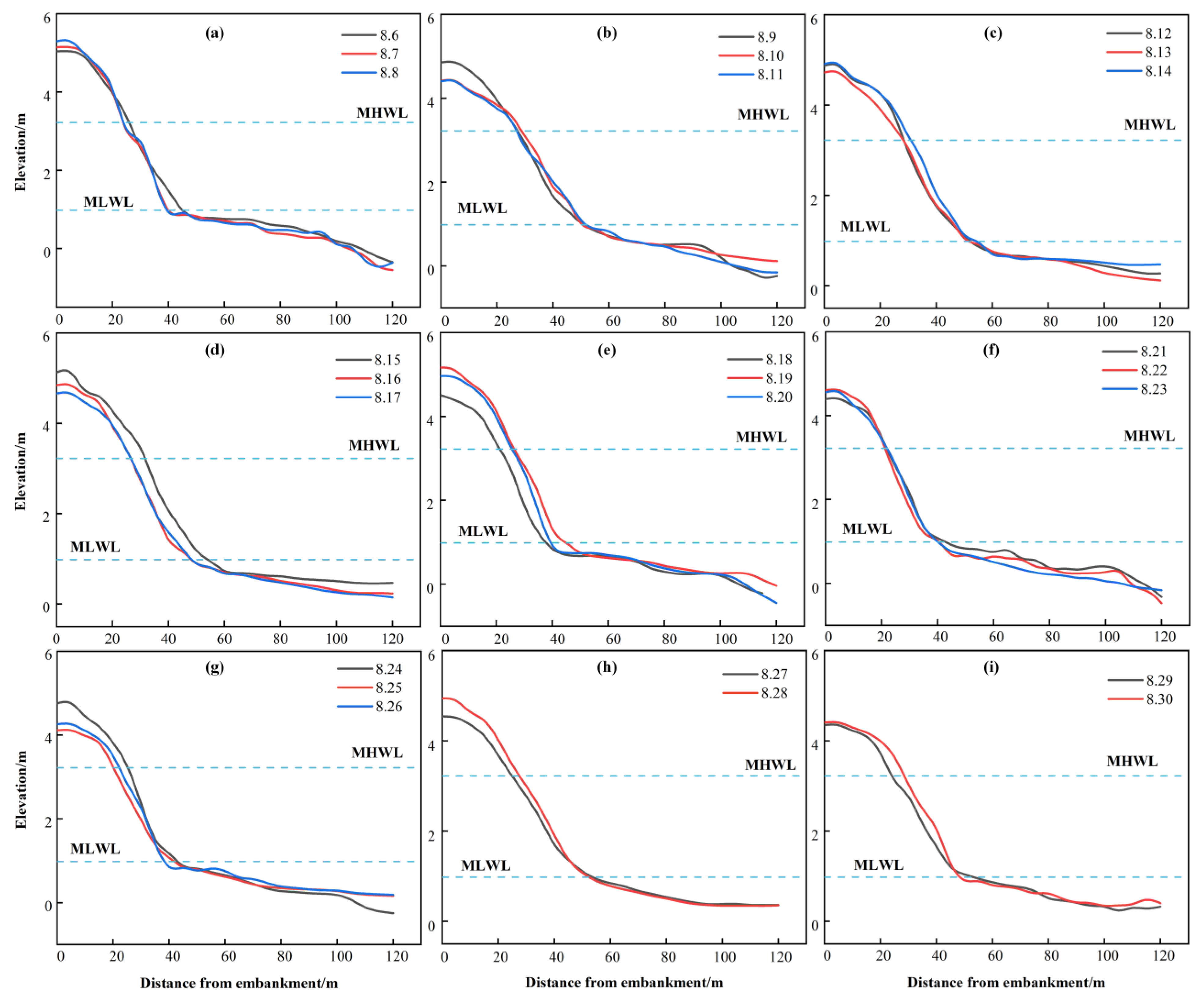

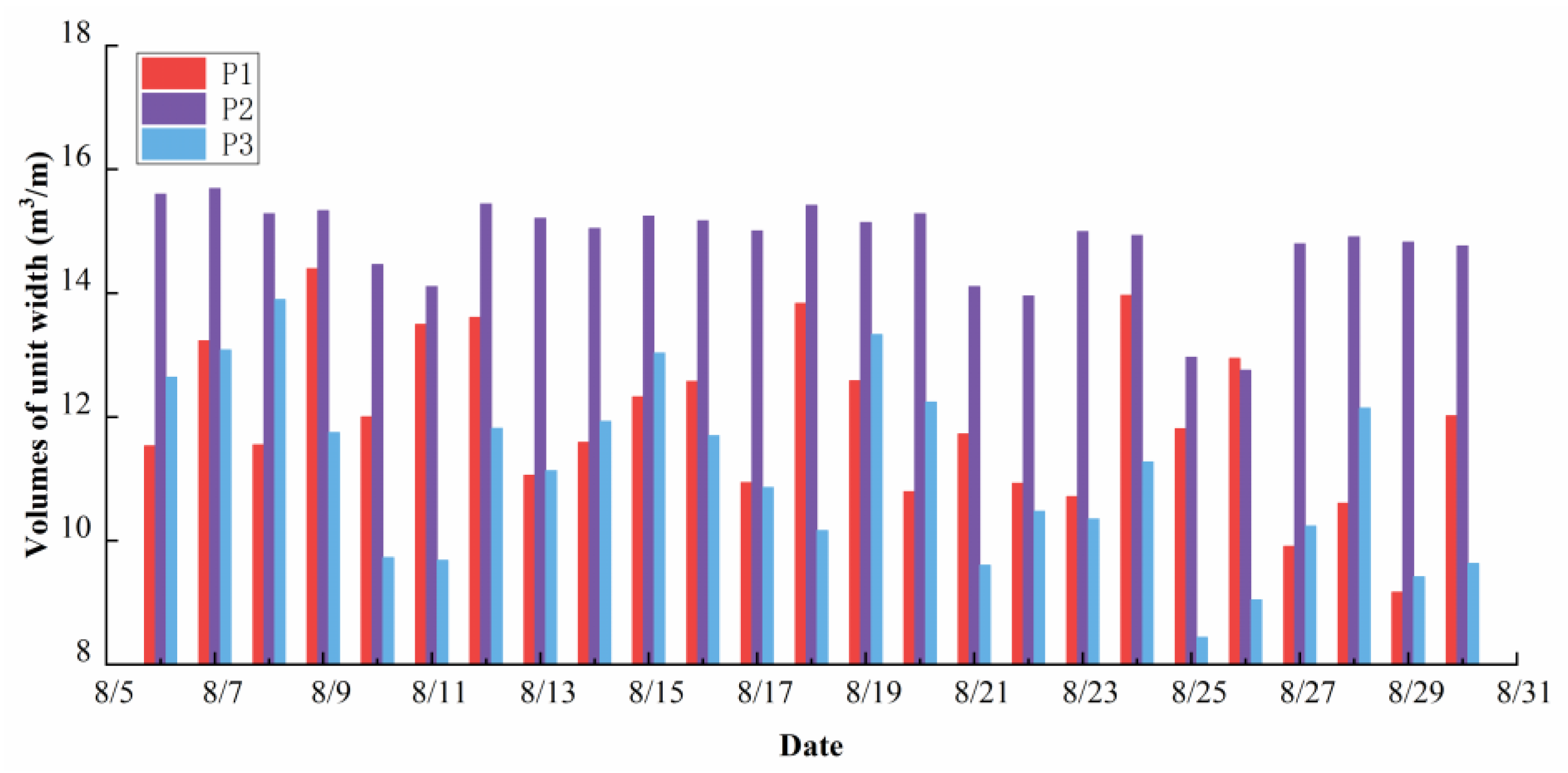
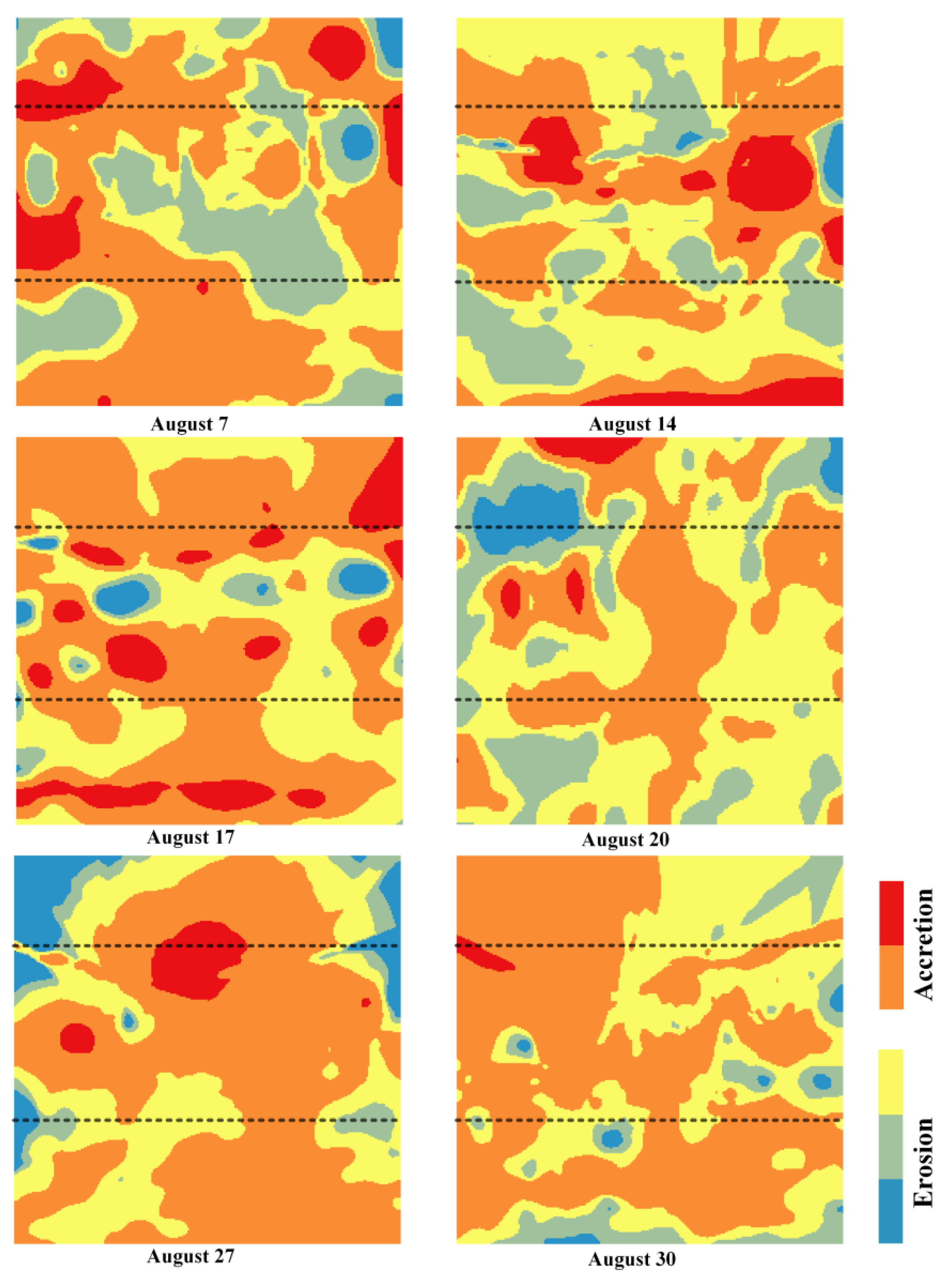

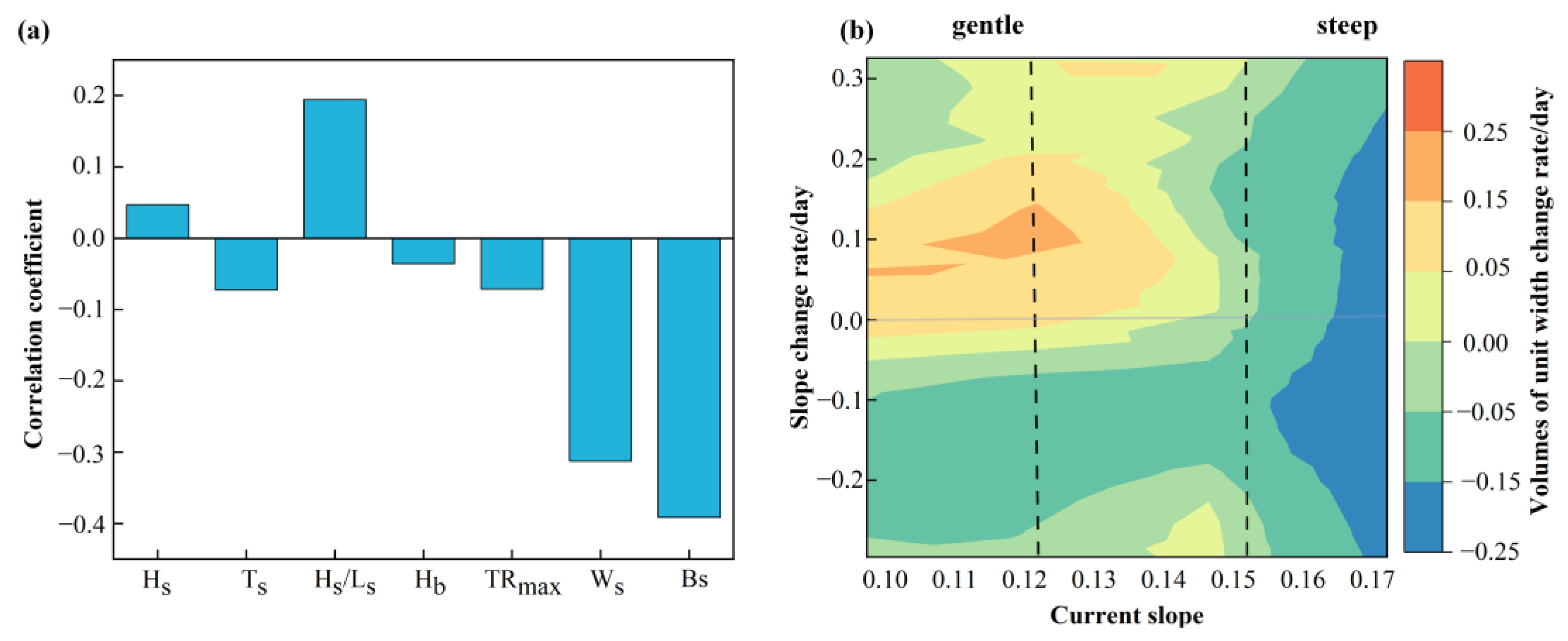
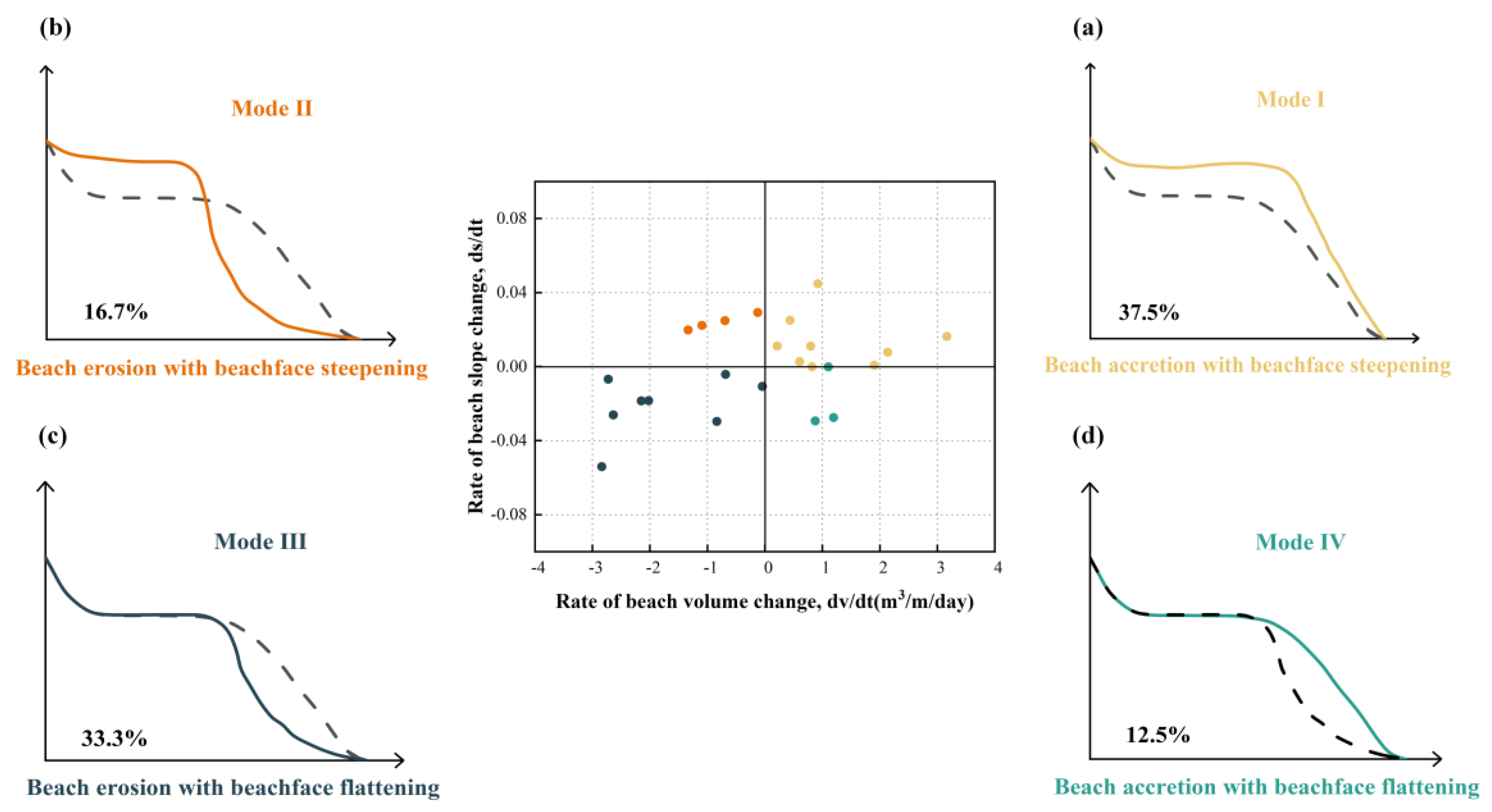
Disclaimer/Publisher’s Note: The statements, opinions and data contained in all publications are solely those of the individual author(s) and contributor(s) and not of MDPI and/or the editor(s). MDPI and/or the editor(s) disclaim responsibility for any injury to people or property resulting from any ideas, methods, instructions or products referred to in the content. |
© 2025 by the authors. Licensee MDPI, Basel, Switzerland. This article is an open access article distributed under the terms and conditions of the Creative Commons Attribution (CC BY) license (https://creativecommons.org/licenses/by/4.0/).
Share and Cite
Liu, L.; Sun, Y.; Liu, R.; Zhu, D.; Chen, Z.; Li, Z. Characterizing Post-Storm Beach Recovery Modes: A Field-Based Morphodynamic Study from Dongdao Beach, China. J. Mar. Sci. Eng. 2025, 13, 1117. https://doi.org/10.3390/jmse13061117
Liu L, Sun Y, Liu R, Zhu D, Chen Z, Li Z. Characterizing Post-Storm Beach Recovery Modes: A Field-Based Morphodynamic Study from Dongdao Beach, China. Journal of Marine Science and Engineering. 2025; 13(6):1117. https://doi.org/10.3390/jmse13061117
Chicago/Turabian StyleLiu, Lulu, Yan Sun, Run Liu, Daoheng Zhu, Zhaoguang Chen, and Zhiqiang Li. 2025. "Characterizing Post-Storm Beach Recovery Modes: A Field-Based Morphodynamic Study from Dongdao Beach, China" Journal of Marine Science and Engineering 13, no. 6: 1117. https://doi.org/10.3390/jmse13061117
APA StyleLiu, L., Sun, Y., Liu, R., Zhu, D., Chen, Z., & Li, Z. (2025). Characterizing Post-Storm Beach Recovery Modes: A Field-Based Morphodynamic Study from Dongdao Beach, China. Journal of Marine Science and Engineering, 13(6), 1117. https://doi.org/10.3390/jmse13061117





